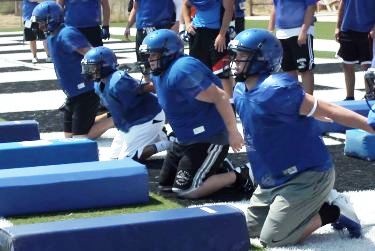By Tamara Hew Butler, DPM, Ph.D., FASCM
When we hear about catastrophic injury and death amongst athletes, we typically think about concussion (1), cardiac arrest (2) and heatstroke. (3) Exercise-associated hyponatremia (EAH) is rarely uttered amongst the "big three", despite its insidious sprawl into more diverse sporting events beyond the ultramarathon; where it was first described. (4)

The tragic deaths of two otherwise healthy 17-year old high school football players from hyponatremic encephalopathy in 2015 (5, 6), however, underscores the need for more education towards translating evidenced-based science into practical advice for athletes.
All EAH deaths are tragic because they are unnecessary and preventable. That the deaths occur in otherwise healthy, young adults and teens makes them even more tragic. Continued over-emphasis of "forced hydration" by coaches, athletic trainers and even physicians to young athletes who are taught to follow orders makes youngsters especially vulnerable to misguided advice from otherwise well-meaning adults. Although clinically significant hyponatremia is rare (1%)(7), the evidence is clear: every single death from EAH is avoidable.
Nearly a decade ago, the perils of overhydration during exercise were confirmed in two seminal studies performed on 488 Boston Marathon runners (8) and 2135 endurance athletes. (7) These reports followed the back-to-back deaths of two female marathon runners in 2002 from EAH. (9) A review of the existing evidence by an international group of experts strongly suggested that hyponatremia resulted from sustained or exuberant fluid intake beyond the body's maximal fluid excretion rates (i.e. fluids consumed above the dictates of thirst or delivered intravenously. (10) But despite strong evidence to the contrary, sporting culture continues to embrace hyperhydration, with another pair of fatal outcomes linked to this misinformation.
American football players are noted for their high sweat rates (>2 liters/hour) due to large body surface area, protective equipment and intensity of play (11) The estimated fluid consumption for college players has been estimated to exceed 12 liters per day, so that high fluid intake has become indoctrinated within football culture. As such, 75% of athletic trainers reported administering pre-game intravenous fluids to football players competing in the National Football League. (12) One college football player developed hyponatremia after receiving five liters of (hypotonic) intravenous fluids while ingesting 3 additional liters of hypotonic fluid within five hours. (13) One of the athletes who recently died of EAH reportedly drank 16 liters of fluid during practice to alleviate muscle cramps. (5)
Thus, while solid evidence published in multiple scientific journals clearly warn against the perils of hyperhydration during exercise, responsible drinking during exercise has yet to be effectively translated onto the playing field. While the concerns regarding dehydration and heatstroke are real and valid, the combination is rare. Current recommended safe drinking guidelines take these risks into account such that extreme hydration is never warranted.
Exercise-associated hyponatremia is a preventable condition. We can consciously control the amount of fluid that enters our body and must reconsider, re-educate and reinforce appropriate fluid intake and intravenous fluid guidelines. The recent preventable deaths of two young football players (as well as several others in the recent past) should serve as a tragic reminder that medical personnel, professional societies and industry must strive harder to connect in order to translate evolving scientific recommendations and guidelines down to the ground level: the athletes.
Tamara "Tami" Hew Butler is an Associate Professor of Exercise Science at Oakland University in Rochester, Michigan, and a member of the MomsTEAM Institute Board of Advisors and of its Heat Injury Working Group.
References
1. Guskiewicz KM, McCrea M, Marshall SW, Cantu RC, Randolph C, Barr W et al. Cumulative effects associated with recurrent concussion in collegiate football players: the NCAA Concussion Study. JAMA 2003; 290(19):2549-2555.
2. Kim JH, Malhotra R, Chiampas G, d'Hemecourt P, Troyanos C, Cianca J et al. Cardiac arrest during long-distance running races. N Engl J Med 2012; 366(2):130-140.
3. Yankelson L, Sadeh B, Gershovitz L, Werthein J, Heller K, Halpern P et al. Life-threatening events during endurance sports: is heat stroke more prevalent than arrhythmic death? J Am Coll Cardiol 2014; 64(5):463-469.
4. Noakes TD, Goodwin N, Rayner BL, Branken T, Taylor RK. Water intoxication: a possible complication during endurance exercise. Med Sci Sports Exerc 1985; 17(3):370-375.
5. Stevens A. Update: Douglas County football player has died. The Atlanta Journal-Constitution 14 A.D. Aug 11.
6. Blevins R, Apel T. Preps Sports Report. The Clarion-Ledger 2014 Aug 27.
7. Noakes TD, Sharwood K, Speedy D, Hew T, Reid S, Dugas J et al. Three independent biological mechanisms cause exercise-associated hyponatremia: evidence from 2,135 weighed competitive athletic performances. Proc Natl Acad Sci U S A 2005; 102(51):18550-18555.
8. Almond CS, Shin AY, Fortescue EB, Mannix R, Wypij D, BinstadtBA et al. Hyponatremia among Runners in the Boston Marathon. N Engl J Med 2005; 352(15):1550-1556.
9. Siegel AJ, Verbalis JG, Clement S, Mendelson JH, Mello NK, Adner M et al. Hyponatremia in marathon runners due to inappropriate arginine vasopressin secretion. Am J Sports Med 2007; 120(5):461.e11-467.e17.
10. Hew-Butler TD, Ayus JC, Kipps C, Maughan RJ, Mettler S, Meeuwisse WH et al. Statement of the Second International Exercise-Associated Hyponatremia Consensus Development Conference, New Zealand, 2007. Clin J Sport Med 2008; 18(2):111-121.
11. Godek SF, Bartolozzi AR, Godek JJ. Sweat rate and fluid turnover in American football players compared with runners in a hot and humid environment. Br J Sports Med 2005; 39(4):205-211.
12. Fitzsimmons S, Tucker A, Martins D. Seventy-five percent of National Football League teams use pregame hyperhydration with intravenous fluid. Clin J Sport Med 2011; 21(3):192-199.
13. Herfel R, Stone CK, Koury SI, Blake JJ. Iatrogenic acute hyponatraemia in a college athlete. Br J Sports Med 1998; 32(3):257-258.








